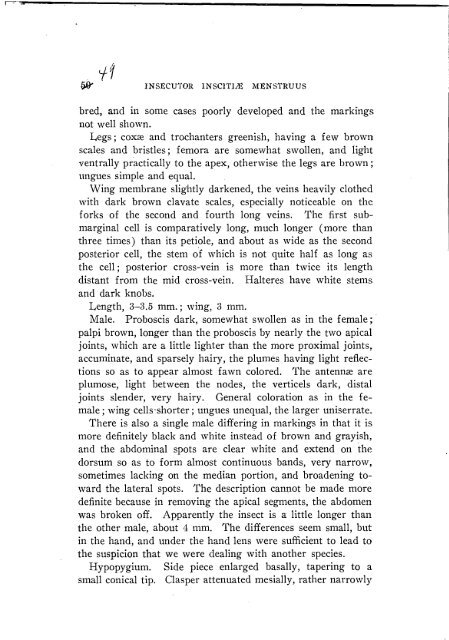You also want an ePaper? Increase the reach of your titles
YUMPU automatically turns print PDFs into web optimized ePapers that Google loves.
INSECUTOR lNSCIT1~ MENSTRUUS<br />
bred, and in some cases poorly developed and the markings<br />
not well shown.<br />
Legs ; coxaz and trochanters greenish, having a few brown<br />
scales and bristles ; femora are somewhat swollen, and light<br />
ventrally practically to the apex, otherwise the legs are brown ;<br />
ungues simple and equal.<br />
Wing membrane slightly darkened, the veins heavily clothed<br />
with dark brown clavate scales, especially noticeable on the<br />
forks of the second and fourth long veins. The first submarginal<br />
cell is comparatively long, much longer (more than<br />
three times) than its petiole, and about as wide as the second<br />
posterior cell, the stem of which is not quite half as long as<br />
the cell ; posterior cross-vein is more than twice its length<br />
distant from the mid cross-vein. Halteres have white stems<br />
and dark knobs.<br />
Length, 3-3.5 mm. ; wing, 3 mm.<br />
Male. Proboscis dark, somewhat swollen as in the female ;<br />
palpi brown, longer than the proboscis by nearly the two apical<br />
joints, which are a little lighter than the more proximal joints,<br />
accuminate, and sparsely hairy, the plumes having light reflections<br />
so as to appear almost fawn colored. The antennae are<br />
plumose, light between the nodes, the verticels dark, distal<br />
joints slender, very hairy. General coloration as in the female<br />
; wing cellsshorter ; ungues unequal, the larger uniserrate.<br />
There is also a single male differing in markings in that it is<br />
more definitely black and white instead of brown and grayish,<br />
and the abdominal spots are clear white and extend on the<br />
dorsum so as to form almost continuous bands, very narrow,<br />
sometimes lacking on the median portion, and broadening toward<br />
the lateral spots. The description cannot be made more<br />
definite because in removing the apical segments, the abdomen<br />
was broken off. Apparently the insect is a little longer than<br />
the other male, about 4 mm. The differences seem small, but<br />
in the hand, and under the hand lens were sufficient to lead to<br />
the suspicion that we were dealing with another species.<br />
Hypopygium. Side piece enlarged basally, tapering to a<br />
small conical tip. Clasper attenuated mesially, rather narrowly
















